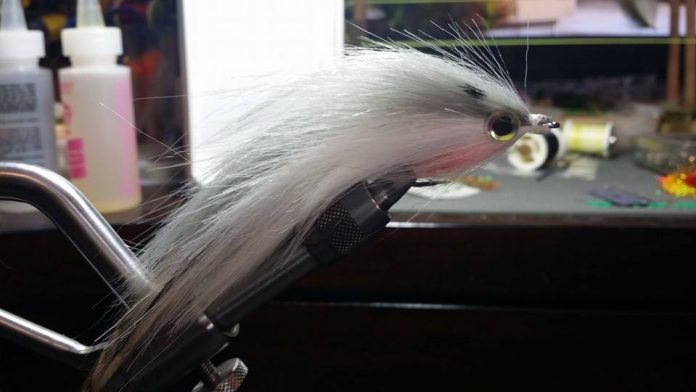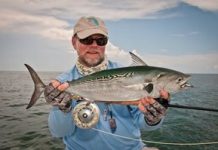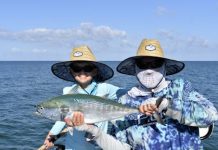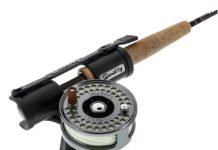
How does one become a saltwater fly fisher? Usually, most are freshwater converts. But these days there are many that have actually started in saltwater. Northern visitors that come to Florida to enjoy our weather can be frequently seen in our airports carrying rod cases.
All fly rod companies make 2, 3, 4 and even 5 and 6 piece outfits that easily conform to on-board baggage requirements. However, I have one word of caution: Checking fly rods in with luggage could be a disaster. Your “hard” case can end up like a pretzel!
Most of my northern clients have spent their fly fishing past with nothing heavier than a 5 wt. rod fishing freshwater trout streams. The most frequently asked question I’m asked is, “How far must I cast to fish saltwater?” Saturday morning TV fishing programs have intimidated them because of the frequent emphasis on distance. If their best previous cast has been 30 feet, they are not going to cast 60 feet with a 10 wt. rod no mater how well balanced the outfit is.
When fishing for freshwater trout on a stream, you have current, structure, feeding stations, wind, water clarity, air and water temperature variations, casting obstacles, drag, and the sun causing shadows, but increasing visibility. Depending on the species, you can have most or all of the same in the salt.
Variations in current that create drag are the most significant problems when trying to tempt a freshwater trout to take your tiny dry fly. Tide can be substituted for current, a dock, piling, or oyster bar would be structure.
On small freshwater streams casting obstacles can be a real problem, but I fished small creeks entering Tampa Bay either wading or in my canoe that were just as challenging. Overhanging mangroves, boats on lifts, docks, and bridges are certainly obstacles to casting.
I’ve caught a lot of saltwater species on small flies and many freshwater fish on bigger offerings. Are there more similarities than you thought? When the wind is flat, I’ve used 6 wt. rods for bonefish and reds in shallow water to allow a stealthy presentation. Other circumstances may require a 10 wt.
Most saltwater species roam looking for forage. If you’ve ever fished a big brown trout river at night you know that they do the same. During the day, these lunkers are under a bank or behind a rock in a deep hole and not actively feeding.
Watch snook under a lighted dock face into the tide waiting for supper. As the tide changes they will reverse position. I fish a lot at night, and the position of a light on a dock will have fish under the dock with an incoming tide and out in open water away from the dock on the outgoing tide. Is this the reason some docks produce better on certain tides, or is the accessibility to the fish the problem?
Trout will generally hold in a “feeding lane” and rise as the fly drifts into their vision. I’ve fished over stubborn brown trout for hours as I tried to imitate the specific mayfly they were engulfing and the horizontal position of the fish never changed. Herein may lie one of the major differences for the aspiring saltwater fly fisher.
Time to cast is a bigger factor in most saltwater applications. Most notable is when a guide is poling you across a shallow flat and seeing a redfish, he calls out the position. Provided you see the fish, and know his direction, you have a set of unique circumstances to overcome. Get the fly in his zone of vision quickly, quietly, naturally and accurately at his depth, with a minimum of false casting…preferably using only one, from a moving boat, at a moving fish, in the wind, without hooking the guide. This will be the defining moment and where failure is most frequently assured.
After attempting this drill a number of times, frustration will set in and trying harder will only make matters worse. The guide isn’t doing too well either! He has worked very hard to position you properly only to have his efforts wasted.
If I’m taking someone out for the first time, we meet at least an hour before I expect the fish to be active. We then go to a quiet area and I show them how to cast, retrieve, clear line, strip strike, and get line on the reel with the outfit they will be using.
I realize books have been written on each of these topics. However, in a short period of time an experienced fly fisher will get it together enough to be able to up the odds for success considerably. On my chazrters, we usually use my equipment because it is better balanced and will work for the specific task. I will hand the rod to my client and ask them to show me how well they can cast.
With this intial evaluation, I’ve seen everything from a cast of 10 feet with a loop the size of the moon to someone who was very proficient. In either case case, these clients had told me during our pre trip phone conversations stories about catching salmon in Alaska, giant rainbows in Colorado, and sailfish in Mexico — on flies, naturally. The ten foot caster could be much more descriptive and vocal. Now he is in trouble! And yes, I’ve had trips where I had to make every cast for clients, they did the retrieve, and we caught fish! Who thinks guiding is easy?
Frequently, a good portion of our trip has been devoted to casting instructions. Some inexperienced anglers have actually doubled the distance from their first attempt. Certainly, this could very well have been done in a back yard on the grass, or in a snow covered parking lot up north. When you do practice, use the heaviest outfit you have. Get some good instruction. Most good fly shops, even 200 miles from saltwater have heavier outfits than you can use. Become familiar with 8 and 9 wt. rods and you will have an enjoyable trip.
Saltwater fly fishing is a blast! This article is really intended to help you put your expectations in perspective and encourage you to join the ranks of many who are discovering this new dimension to our sport.
Information is available by contacting me at:
pat4jaws@hotmail.com
or 727-360-6466.
Click here for my web site
Capt. Pat Damico
St. Pete Beach, Fl
- Captain’s Corner:Pat Damico - June 25, 2019
- Flat water makes seeing tarpon easier - May 17, 2017
- Warm rivers holding plenty of targets for fly fishermen - February 16, 2017











